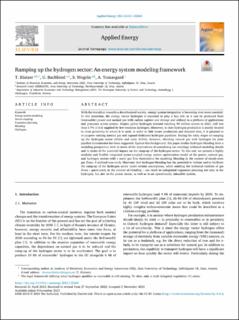| dc.description.abstract | With the transition towards a decarbonized society, energy system integration is becoming ever more essential. In this transition, the energy vector hydrogen is expected to play a key role as it can be produced from (renewable) power and natural gas with carbon capture and storage and utilized in a plethora of applications and processes across sectors. Despite global hydrogen demand reaching 94 million tonnes in 2021, still less than 0.7% of it is supplied by low-emission hydrogen. Moreover, to date hydrogen production is mostly located in close proximity to where it is used. In order to link future production and demand sites, it is planned to re-purpose existing natural gas and expand dedicated hydrogen pipelines. During the early stages of ramping up the hydrogen sector (2020s and early 2030s), however, blending natural gas with hydrogen for joint pipeline transmission has been suggested. Against this background, this paper studies hydrogen blending from a modeling perspective, both in terms of the implications of considering (or omitting) technical modeling details and in terms of the potential impact on the ramp-up of the hydrogen sector. To this end, we present a highly modular and flexible integrated sector-coupled energy system optimization model of the power, natural gas, and hydrogen sectors with a novel gas flow formulation for modeling blending in the context of steady-state gas flows. A stylized case study illustrates that hydrogen blending has the potential to initiate and to facilitate the ramp-up of the hydrogen sector under certain assumptions, while omitting the technical realities of gas flows – particularly in the context of blending – can result in suboptimal expansion planning not only in the hydrogen, but also in the power sector, as well as in an operationally infeasible system. | en_US |

